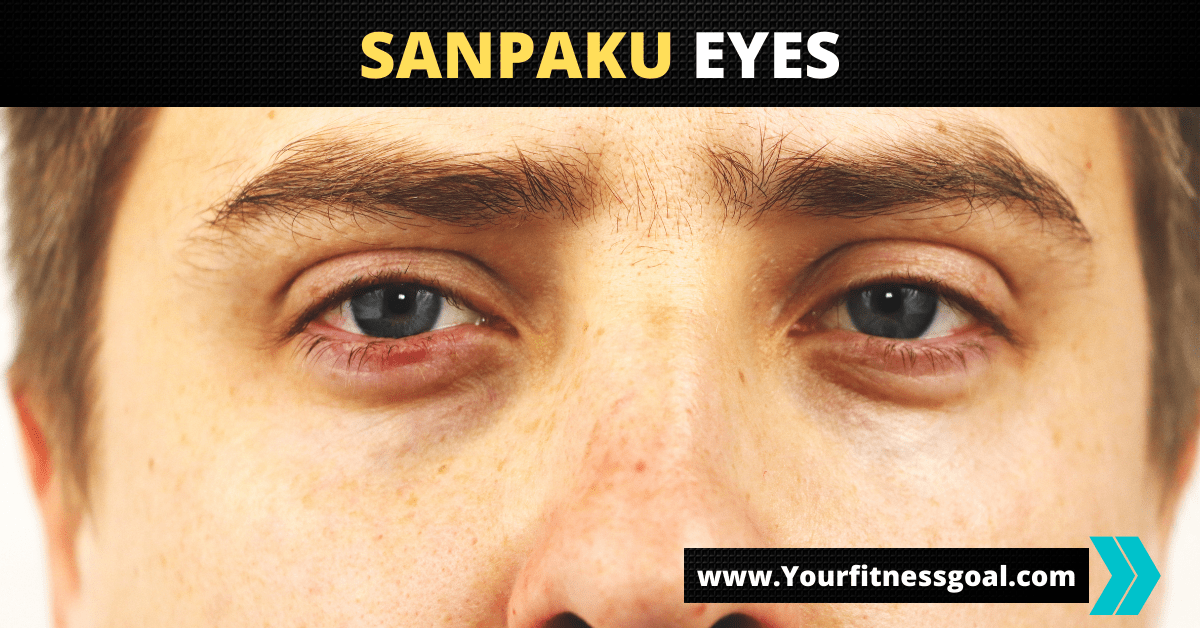Your eyes are termed sanpaku eyes if you can see white above or below the iris.
At the point when a child is conceived, the iris, or hued some portion of the eye, is typically wonderfully adjusted between the upper and lower eye covers. It comes into contact with both the upper and lower lids, ensuring that no white, or sclera, is visible above or beneath. The sclera is apparent just to one side and right of the iris. This shows a reasonable and sound sensory system. The child is ready and in for the most part strong well-being.
The iris rises to the point where it partially vanishes beneath the upper eyelid when a person dies. Below is the white sclera. Such a look is referred to as sanpaku eyes in Oriental Medicine, which means “three whites” visible. Three whites, or sanpaku, is a typical symptom of illness or exhaustion. It is particularly acute in those who are terminally ill and on the verge of death.
Three whites indicate a neurological system that is severely out of equilibrium. The mind, body, and soul of such a person are out of sync with the cosmos’ bigger forces. The individual’s intuition is askew, and his or her ability to judge people and situations is lacking.
How they’re supposedly different –
From happiness to laughter to boredom to disdain, your eyes and their movements may reveal a lot of information about your mood and feelings.
While your look may wait on somebody you find alluring or engaging, you may rapidly turn away from something that terrifies or upsets you. Your understudies additionally widen when you experience forceful feelings, including apprehension, outrage, and love (or desire).
A few specialists even accept eyes can offer hints to hidden character attributes, offering support for the possibility that your eyes offer a brief look at your spirit.
The different recommended qualities of “mental case eyes” appear to repeat the overall conviction that individuals with ASPD have no feelings to show.
These portrayals include:
- a “heartless” gaze
- extremely dim irises, or eyes that seem dark
- reptilian-like eyes
- and so on …
What Else about ‘sanpaku’ eyes?
As per Japanese face perusing, different components of your face can offer an understanding of your character, capacities, and encounters.
Sanpaku, which signifies “three whites,” is one component of face perusing.
If you take a gander at your own eyes in a mirror, you’ll see the whites (sclera) on one or the other side of every iris.
The whites (sclera) on either side of each iris can be seen in a mirror if you gaze at your own eyes. Your eyes are termed sanpaku eyes if you can see white above or below the iris.
Sanpaku eyes are broken further into two types:
- Yang sanpaku – This alludes to the white over the iris. It’s said to propose you face all the more danger from the inside. At the end of the day, you’re bound to struggle to oversee undesirable feelings, which could adversely influence both your conduct and generally speaking prosperit.
- Yin sanpaku – This alludes to the white underneath the iris. Customarily, yin sanpaku proposes you may confront some sort of danger or peril from the world, or that you have a proclivity to put yourself in danger.
Yang sanpaku, specifically, got related with psychological maladjustment and psychopathic characteristics, including:
- hostility
- the propensity toward irate or fierce upheavals
- doubt of others
- helpless poise
How to identify symptoms of sanpaku eyes?
Psychopathy is nearly impossible to detect in someone’s eyes or any other physical traits.
When confronted with frightening visuals, those with specific psychopathic tendencies may display less pupil dilation. However, as experts have pointed out, this may be less visible in everyday life, particularly if you don’t know what to look for.
Even yet, the absence of dilatation could be due to something else. Also, persons with predominantly secondary psychopathic features did not appear to have decreased pupil response.
The same may be said for making eye contact. For a variety of reasons, people may or may not make eye contact during interactions. They could be shy or just nervous. They may have social anxiety or autism.
Other widespread misconceptions regarding psychopathy are also debunked by research.
For instance, individuals with ASPD can:
They feel emotions, even if they find it difficult to recognize and control them.
establish and sustain ties with others
feel lament after undesirable results, however, they struggle to utilize the experience to settle on various decisions later on.
When Sanpaku eyes can be a red flag?
Rising sun
On the off chance that you have white sclera above or beneath your iris, think of it as an individual essentialness gauge. Ordinarily, for a large portion of our lives, white shows just on the two sides of the shaded circle. A glance in the mirror and at faces around you affirms this. At the point when white shows on three sides, it is an energy readout; the Japanese call it sanpaku eyes, which implies three whites.
In the early stages, we frequently see white on each side or more the iris. Like the morning dawn, the climbing iris reflects the undiscovered indispensable energy to serve this youngster a lifetime.
Setting Sun
The iris appears to set or roll back up into the head when our vitality drops, usually in the evening of our life cycle, revealing white underneath the iris. Nancy’s eyes have sanpaku (three whites) in this snapshot.
Call to action –
All things being equal, sanpaku eyes proposes an absence of groundedness; that your energy will, in general, be up and out as opposed to focused. Think of it as an encouragement to pull together. What is your eating regimen or potentially a way of life dissipates your energy? Chinese Five Element medication considers sanpaku a kidney and Water Element irregularity.
You’ll feel healthier and more vital as your irises return to normal. Sanpaku eyes can be caused by a variety of medical disorders. You may dismiss the sensationalist claims about sanpaku on the internet; at the end of the day, sanpaku is only a visual cue indicating it’s time to replenish your energy.
Conclusion
It’s in every case best to try not to make presumptions about character dependent on appearance or non-verbal communication. Behavioral conditions, similar to some other emotional wellness conditions, appear in changed ways from one individual to another.
Just prepared emotional well-being experts to have the information and skill expected to precisely analyze ASPD. They’ll make this determination by investigating long-standing examples of abuse and control in an individual’s conduct — not by investigating their eyes.

Hey, y’all! I’m Akshay!
I’m SO excited you’re here! I’m super passionate about nutrition and specialize in teaching others how to lose weight through healthy, low-carb eating along with Yoga and exercises. Here at Yourfitnessgoal, we believe in quality over quantity and that diet is EVERYTHING when it comes to your health and well-being. In short, we believe in a Fit and healthy lifestyle.

